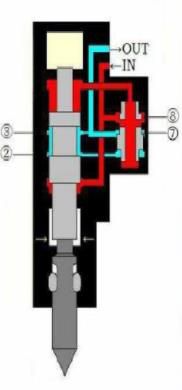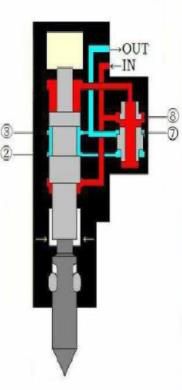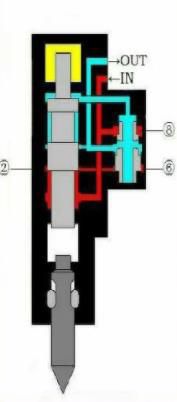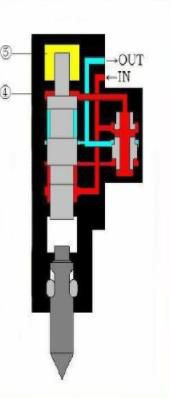A hydraulic breaker hammer is a type of construction machinery that is mounted on excavators, backhoes, skid steers, mini-excavators, and stationary plants.
Driven by hydraulic power it breaks rocks into smaller sizes or demolishes concrete structures into manageable pieces.
This engineering article classifies the hydraulic breaker hammer working principle, or How does a hydraulic breaker hammer work.
If you have an engineering background, this section will help you understand the technical aspects of how a hydraulic hammer works and operates.
If you think these flow charts are tedious and tough to understand, you can move straight to the conclusion.To clarify the technical process of the working principle, four images and one video are going to be used as below.
For starter, watch the short video for a brief understanding.
Notion:
1-8 means chambers of oil flow
Red areas are full of high-pressure oil flow
Blue areas are full of low-pressure oil flow
Chambers 3, 7 always have low pressure because they connect to “out”
Chambers 1, 8 always have high pressure because they connect to “in”
The pressure in chambers 2, 4, 6 changes with piston movement
1.High-pressure oil enters and fills chamber 1 and 8, acting on the piston end-face and pushing it upward.
hydraulic breaker working principle
2. When the piston moves upward towards its limit, chamber 1 and 2 get connected and oil flows from chamber 2 to 6.The control valve moves upward due to the difference in pressure (oil pressure in chamber 6 is higher than in 8).
hydraulic breaker working principle
When the control valve reaches its upper limit, the input hole connects to oil flow in chamber 8, which makes oil flow into chamber 4.Owing to the high oil pressure of chamber 4, together with nitrogen backups, the piston travels down.
hydraulic breaker working principle
4. When the piston travels down and hits the chisel, chamber 3 and 2 get connected, and they both connect to chamber 6.Because of the high oil pressure in chamber 8, the control valve travels down and the input hole connects to chamber 7 again.
Then a new circulation begins

Conclusion
One sentence is enough to sum up the hydraulic hammer working principle:“The relative position change of piston and valve, which is driven by oil flow going “in” and “out,” transforms hydraulic power into impact energy.”
To know more about hydraulic hammers, visit “the ultimate buying guide on hydraulic breaker hammers“.
Please contact my whatsapp:+8613255531097
A hydraulic breaker hammer is a type of construction machinery that is mounted on excavators, backhoes, skid steers, mini-excavators, and stationary plants.
Driven by hydraulic power it breaks rocks into smaller sizes or demolishes concrete structures into manageable pieces.
This engineering article classifies the hydraulic breaker hammer working principle, or How does a hydraulic breaker hammer work.
If you have an engineering background, this section will help you understand the technical aspects of how a hydraulic hammer works and operates.
If you think these flow charts are tedious and tough to understand, you can move straight to the conclusion.To clarify the technical process of the working principle, four images and one video are going to be used as below.
For starter, watch the short video for a brief understanding.
https://youtube.com/shorts/ZzIwHXb2V5w?feature=share
Notion:
1-8 means chambers of oil flow
Red areas are full of high-pressure oil flow
Blue areas are full of low-pressure oil flow
Chambers 3, 7 always have low pressure because they connect to “out”
Chambers 1, 8 always have high pressure because they connect to “in”
The pressure in chambers 2, 4, 6 changes with piston movement
1.High-pressure oil enters and fills chamber 1 and 8, acting on the piston end-face and pushing it upward.
hydraulic breaker working principle
2. When the piston moves upward towards its limit, chamber 1 and 2 get connected and oil flows from chamber 2 to 6.The control valve moves upward due to the difference in pressure (oil pressure in chamber 6 is higher than in 8).
hydraulic breaker working principle
When the control valve reaches its upper limit, the input hole connects to oil flow in chamber 8, which makes oil flow into chamber 4.Owing to the high oil pressure of chamber 4, together with nitrogen backups, the piston travels down.
hydraulic breaker working principle
4. When the piston travels down and hits the chisel, chamber 3 and 2 get connected, and they both connect to chamber 6.Because of the high oil pressure in chamber 8, the control valve travels down and the input hole connects to chamber 7 again.
Then a new circulation begins

Conclusion
One sentence is enough to sum up the hydraulic hammer working principle:“The relative position change of piston and valve, which is driven by oil flow going “in” and “out,” transforms hydraulic power into impact energy.”
To know more about hydraulic hammers, visit “the ultimate buying guide on hydraulic breaker hammers“.
Please contact my whatsapp:+8613255531097
Post time: Apr-17-2023


